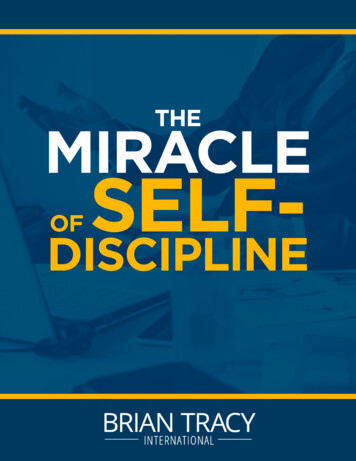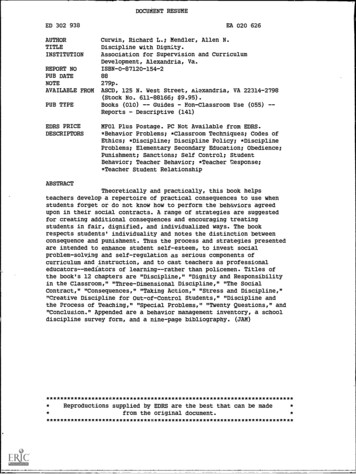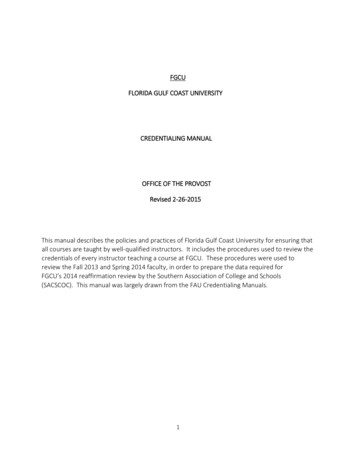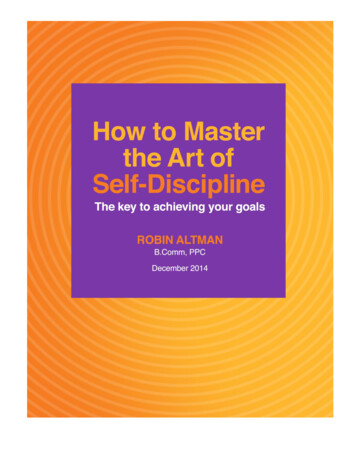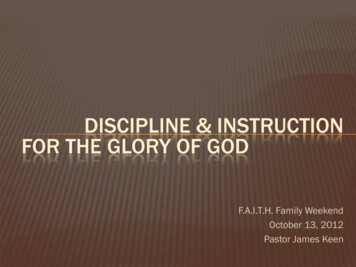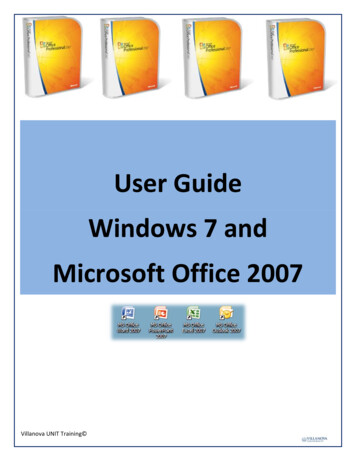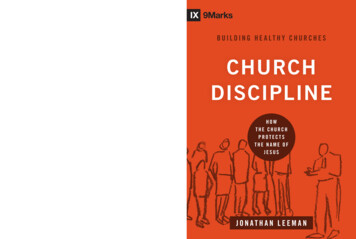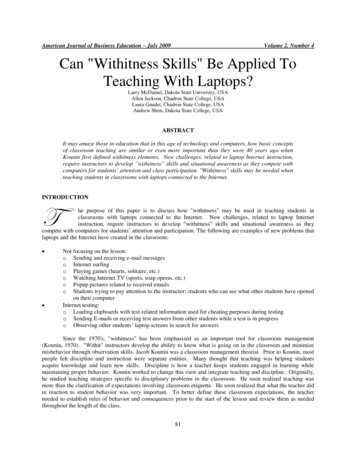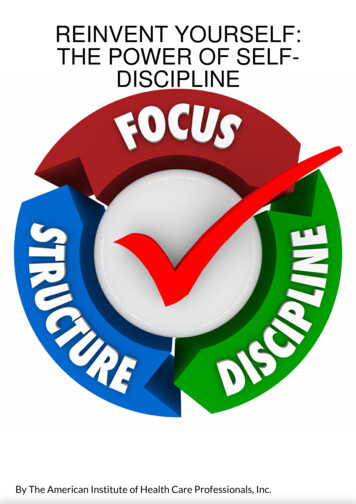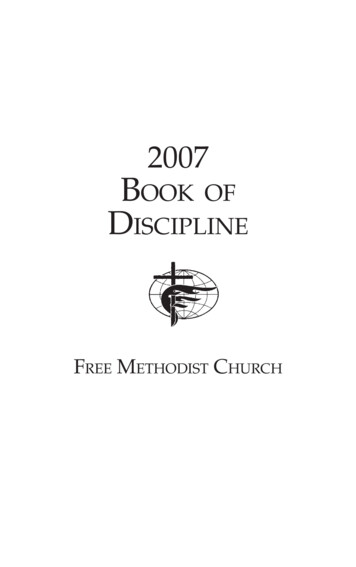
Transcription
2007BOOK OFDISCIPLINEFREE METHODIST CHURCH
The Free Methodist ChurchofNorth America2007Book of Discipline“Keep watch over yourselves and all the flockof which the Holy Spirit has made you overseers.Be shepherds of the church of God, which hebought with his own blood” (Acts 20:28).
The Board of EditorsBishop David W. Kendall (chair)Barbara Fox (secretary)Carolyn MartinVernon SnyderUnless otherwise noted all scripture quotations are taken from the HOLYBIBLE, NEW INTERNATIONAL VERSION . NIV . Copyright 1973, 1978,1984 by International Bible Society. Used by permission of ZondervanPublishing House. All rights reserved.Copyright, 2008The Free Methodist Publishing HouseLight and Life CommunicationsIndianapolis, INPrinted in U.S.A.ii
ForewordThe Free Methodist Church of North America meets as a deliberativebody, called a General Conference, approximately every four years.It is a time when Free Methodists join in celebrative worship, hear theWord, pray for God’s guidance, debate the issues, decide on resolutions, set new directions, renew friendships and enjoy fellowshipwith each other.Ministerial and lay delegates from the annual conferences across theUnited States and in other parts of the world, along with the bishops,meet together to clarify the mission, renew the vision, care fordenominational business and examine the Book of Discipline. Representatives from Free Methodist institutions, associations and auxiliaries as well as executive directors with their leadership teams bringreports and add their insights.The Book of Discipline includes the common constitution of the FreeMethodist Church worldwide. It is a blend of history, roots andinternational contemporary mission. It is the ecclesiastical and organizational manual of the church. It represents the heart and vision ofthe Free Methodist people who serve faithfully at the call of the LordJesus Christ.We pray that this 2007 Book of Discipline will be a useful resource toguide the church in effective ministry under the direction of the HolySpirit as together we live and serve our Master in the neighborhoodsof our world.— The Editorsiii
Contents2007 Book of DisciplineParagraphPageIntroductionPurpose and Character of the Free Methodist ChurchThe Biblical Concept of the ChurchHistorical Heritage and PerspectiveThe Needs of PersonsDistinctive Principles9101314Chapter 1The Constitution of the Free Methodist ChurchPreambleArticles of ReligionMembership100101-131150-160171728General Organization200-204Restrictive Rules and Methods of Amendment of theCommon Constitution of Free Methodism 210-213General Conferences220-222World Conference230Council of Bishops24033Chapter 2The Constitution (continued)34354248Chapter 3The Christian JourneyThe Goal of the Christian JourneyAs Regards GodAs Regards Ourselves and OthersAs Regards the Institutions of GodAs Regards the ChurchResources for 4303500515259677478v
apter 4General AdministrationGeneral Conference Free Methodist Churchof North AmericaBishopsBoard of AdministrationFinance and PensionFree Methodist CommunicationsFree Methodist World MissionsFree Methodist FoundationChaplainsAssociation of Human Service MinistriesEducational InstitutionsAuxiliary OrganizationsChapter 5Annual ConferencesPreambleOrganizationOfficersStanding Boards and CommitteesThe Ordained MinistryElder’s OrdersConference Membership Transfers andTerminationSpecial Cases of AppointmentsLocated Deacons and Located EldersEvaluation of Ministry EffectivenessChapter 6The Local ChurchPreamble – Mission and VisionCharacteristicsMembershipLocal Church AdministrationStanding Boards and CommitteesProperty and Financevi
Local Ministerial CandidatesDeaconsPastoral Staff AssistantsFormation of New pter 7Church OrderPreambleHealthy Biblical CommunityReview BoardsConfidentialityProcessing AppealsChapter 8The RitualBaptismHoly Communion:The Sacrament of the Lord’s SupperThe Solemnization of MatrimonyThe Burial of the DeadOrdination of EldersConsecration of DeaconsDedication of ChurchesMinisterial MembershipLay MembershipChapter 9AppendixesArticles of Incorporation of theFree Methodist Church of North America 9000Bylaws of the Free Methodist Churchof North America9100253257Index267vii
Mission StatementThe mission of the Free Methodist Church is to make known to allpeople everywhere God’s call to wholeness through forgiveness andholiness in Jesus Christ, and to invite into membership and to equipfor ministry all who respond in faith.Vision StatementThe vision of the Free Methodist Church is to be a healthy biblicalcommunity of holy people multiplying disciples, leaders, groupsand churches.viii2007 Book of Discipline
Purpose and Character of the Free Methodist ChurchIntroductionPurpose and Characterof the Free Methodist ChurchThe Free Methodist Church is best understood within theframework of the biblical concept of the church, the perspective provided by its historical heritage and its commitment to the needs of man.The Biblical Concept of the ChurchIt is clear from Scripture that the church is of God and forpeople. It is His creation. Christ is its head. The church isthe people of God chosen for a purposeful partnership inaccomplishing the will of God on earth. More than eightymetaphors, word pictures, relating to the church appearin the New Testament. Each portrays a more profoundreality than does the picture it brings to mind. The pictures together make clear the nature and mission of thechurch. Paul speaks of the church as “body,” “building,”and “bride.” The most inclusive and perhaps the most significant metaphor is “body of Christ.” The redeemed arespoken of as “members of the body.”What is the profound truth that the many word picturesconvey? God – Father, Son, and Holy Spirit – takes a redeemed people into partnership to share in His activitiesand to realize His purposes. The church is the organic,corporate instrument God has chosen to remake peopleand society. It has a mission of holy love. The church exists to produce Christlikeness in all people and their institutions. Thus our mission may be described as participation with God in bringing holiness and love to bearupon the sins, hurts, and needs of all people. This description of our mission is both individual and social. It pointsto a social relationship of all people to God and to eachother described in Scripture as “the kingdom of God.”The metaphors of the New Testament are made emphaticby the greatest portrait of all – the Incarnation, God madeflesh. The church, enlightened by the Incarnation, contin-2007 Book of Discipline9
Purpose and Character of the Free Methodist Churchues the teaching and the ministry of its Lord on earth.When the church is acting under the headship of its Lordand the inspiration of the Holy Spirit, it continues the storybegun in the book of Acts. Many are its wonderful achievements since the first century, and many more may yet berealized in the unfolding drama of the acts of the HolySpirit through redeemed people.The New Testament reminds us that the church visible isnot the church ideal. Because the church is a divine-humanpartnership, sharing not only in the holy love of its founderbut in the blemishes of its humanity, it is ever in need ofrenewal. God takes the same risk with the church in redemption as He did when He granted people freedom in creation. Just as God, the Holy Spirit, used the hands of theApostle Paul in “special miracles” so He can use His churchtoday. The results will be the same – the Word of the Lordwill grow mightily and will prevail (Acts 19:11 and 20).Historical Heritage and PerspectiveFree Methodists consider the story of the church in thebook of Acts and the other New Testament writings as theirprimary heritage. Generation after generation derives fromthis record their main source of direction and renewal.Followers of God have wrestled with issues both old andnew throughout the centuries just as they do now. Theentire history of the church is instructive for us.Free Methodists claim a line of evangelical descent spelledout in large terms as follows: They trace their spiritualheritage through men and women of deep personal pietyin all ages who have shown that it is possible to maintainthe glow of spiritual fervor in the midst of paganism, apostasy, and the ofttime corruption of the established church.The lineage of the Free Methodist Church begins with thepeople of God in the Old and New Testaments, and includes influences and contributions from the multitude ofrenewal movements in western Christianity: Wycliffe andthe German Moravians (from whom Wesley learned the102007 Book of Discipline
Purpose and Character of the Free Methodist Churchconcept of “the witness of the Spirit”); the sixteenth century Reformation with its many counterbalancing renewalmovements, not the least of which were the Arminiancorrectives (which taught that Christ’s salvation was forall mankind without limit, but that it must be freely chosen); the Catholic-Anglican tradition; the English Puritaninfluence; the Methodist tradition; and the ensuing vigorous nineteenth century holiness movement. God has usedthese and others across the ages to make the unchangingChristian gospel known more clearly. In sum, Free Methodists identify with the flow of history of the Christianchurch while maintaining distinctive evangelical and spiritual emphases.The contributions from church history may be detailed asfollows: The Reformation heritage is reflected in their commitment to the Bible as the supreme rule of faith and life,and to salvation by grace through faith.The Catholic-Anglican heritage appears in their concernfor church order and appreciation for liturgical form. Theiremphasis on the essentials of the faith allows for their openness towards differing views on such subjects as modes ofbaptism and the millennium.The Methodist heritage is shown in theological, ecclesiastical and social concerns articulated by the Revered JohnWesley and his associates in the eighteenth century and reaffirmed through the holiness movement of the nineteenth.Theologically, they are committed to the WesleyanArminian affirmation of the saving love of God in Christ.Through prevenient grace He seeks to bring every individual to himself but grants to each the responsibility ofaccepting or rejecting that salvation. Salvation is a livingrelationship with God in Jesus Christ, giving the believera legal position of righteousness, and therefore affirming the security of all who continue in fellowship withHim. Along with the Arminian emphasis on the universal offer of salvation, John Wesley rediscovered the principle of assurance through the witness of the Holy Spirit.He declared a scriptural confidence in a God who is able2007 Book of Discipline11
Purpose and Character of the Free Methodist Churchto cleanse the hearts of believers from sin here and nowby faith, fill them with the Holy Spirit, and empower themfor carrying out His mission in the world. John Wesleywrote of himself and his brother Charles, “In 1729 twoyoung men in England, reading the Bible, saw they couldnot be saved without holiness, followed after it, and incited others so to do. In 1737 they saw, likewise, that menare justified before they are sanctified; but still holinesswas their object. God then thrust them out to raise up aholy people.”Ecclesiastically, the Methodist heritage is continued in FreeMethodist organization. There are lines of responsibilityconnecting local, district, conference, and denominationalministries. Small groups of believers are accountable toone another for growth in Christian life and service. FreeMethodists are concerned for the whole church, not justthe local congregation. They value the leadership of bishops, superintendents, pastors, and lay leaders who provide counsel and direction to the church.Born at a time when representative government was being developed by free societies, the Free Methodistfounders reaffirmed the biblical principle of lay ministry. Free Methodists recognize and license unordainedpersons for particular ministries. They mandate lay representation in numbers equal to clergy in the councilsof the church.Socially, from their early days, Free Methodists displayedan awakened conscience characteristic of the earlyWesleyan movement. Their outspoken action against theinstitution of slavery and the class distinction inherent inthe rental of pews to the wealthy demonstrated the spiritof true Methodism. Although issues change, the sensitivesocial conscience remains, evidenced by continuing activeparticipation in the social concerns of the day.During the nineteenth century, the holiness movement, arising in American Methodism but spreading through othernations and denominations, called Christians to deeper levels of relationship with God and greater concern for the122007 Book of Discipline
Purpose and Character of the Free Methodist Churchneeds of hurting humanity. Within this context, the Reverend Benjamin T. Roberts and other ministers and laypersons in the Genesee Conference of the Methodist EpiscopalChurch in western New York, raised a protest against theological liberalism, unhealthy compromise on pressing social issues and loss of spiritual fervor.Between 1858 and 1860, a number of these leaders wereexcluded from the Methodist Episcopal Church on various charges and allegations. In reality, the primary issuewas their proclamation of the basic principles ofMethodism, especially the doctrine and experience of entire sanctification. Appeals made to the General Conference of May 1860 were denied. Those excluded could notjoin any other Methodist body, for there was none thatagreed with them on the issues on which they were thrustout. Therefore, the Free Methodist Church was organizedby a convention of lay members and ministers which metat Pekin, Niagara County, New York, on August 23, 1860.The first General Conference met on the second Wednesday of October, 1862, at Saint Charles, Illinois.The Free Methodist Church, since its inception, continuesto expand around the world through missionary outreach,the development of additional general conferences and acoordinating world organization.The Needs of PersonsFree Methodists are committed to the task of understanding the most important needs of persons, institutions andvarying cultures so that it may minister meaningfully andredemptively to them. In the high priestly prayer of JesusChrist, He called upon believers to live in this world actively and intelligently in order that the world might beled both to “know” and to “believe.”Free Methodists are aware of the demonic forces in theworld which debase people, pervert the good and leadpeople and institutions to ruin. They attempt to help peopleby restoring personal meaning in a time of depersonalizing developments.2007 Book of Discipline13
Purpose and Character of the Free Methodist ChurchFree Methodists openly rebuke anything in law, personsor institutions which violates the dignity of persons created in the image of God. They are committed to takingadvantage of opportunities where as individuals, localchurches, conferences and denomination they can minister healing and redemptive helpfulness in the world.Distinctive PrinciplesFree Methodists seek to express the concept of the churchof Jesus Christ, their historical perspective and the needsof persons in specific principles and commitments.Free Methodists today seek to continue the mission of firstcentury Christianity which was recovered by John Wesleyand the early Methodists who declared they existed “toraise up a holy people.”Free Methodists are a fellowship of Christians in earnest toget to heaven and committed to working in the world for thesalvation of all people. They place their commitment to Christand His church above all others. They keep themselves freefrom alliances which would compete for their highest loyalty and from all which would encumber and compromisetheir effective witness to the Trinitarian faith and the believer’sdependence upon the grace of God. The Christian denieshimself, takes up his cross daily, and follows Jesus. He conforms to all the will of God as made known in His Word, andbelieves the conditions of salvation are the same now as theywere in the days of the apostles.In doctrine, Free Methodists’ beliefs are the standard beliefs of evangelical, Arminian Protestantism, with distinctive emphasis on the scriptural teaching of entire sanctification as held by John Wesley.In experience, Free Methodists stress the reality of an inner cleansing and power that attests the doctrine of entiresanctification, both in the inward consciousness of believers and in their outward life.Their worship is characterized by simplicity and freedomof the Spirit, untrammeled by elaborate ritual.142007 Book of Discipline
Purpose and Character of the Free Methodist ChurchFree Methodists maintain a life of daily devotion to Christthat springs from inward holiness and separates the Christian from the world, even while he/she lives in the world.They believe the best way to keep worldliness from invading the church is for the church to invade the worldwith redemptive purpose.They practice a complete consecration of every power andpossession to the service of God and all people everywhere.They believe so strongly in the mission of the church thatthey are committed to responsible stewardship in finance.Therefore they do not need to resort to commercial effortsto support the cause of Christ.Free Methodists recognize that God gives spiritual gifts ofservice and leadership to both men and women. Since maleand female are both created in the image of God, that image is most fully reflected when both women and men workin concert at all levels of the church. Therefore, all positionsin the church are accessible to any whom God has called.Free Methodists sense a special obligation to preach thegospel to the poor. The provisions of the gospel are for all.The “glad tidings” must be proclaimed to every individualof the human race. God sends the true light to illuminateand melt every heart. Jesus set the example. Of His ministry it was reported, “The blind receive their sight, and thelame walk, the lepers are cleansed, and the deaf hear, thedead are raised up, and the poor have the gospel preachedto them.” This preaching to the poor was the crowningproof that He was the one who should come. In this respect the church must follow in the footsteps of Jesus.Free Methodists are committed to the New Testament ideals of simplicity and modesty as a style of life. They wishto call attention, not to themselves, but to their Lord.These distinctives of the Free Methodist Church from itsorigin are still living issues. In every era and every landthese distinctives are the witnesses of the church, needingutterance clear and strong that they may be heard andheeded amidst the world’s confusing and misleading voices.2007 Book of Discipline15
The Constitution of the Free Methodist ChurchPar. 100Chapter 1The Constitution of theFree Methodist ChurchPreamble¶100In order that we may wisely preserve and pass on to posterity the heritage of doctrine and principles of Christianliving transmitted to us as evangelicals in the ArminianWesleyan tradition, insure church order by sound principles and ecclesiastical polity, and prepare the way forevangelization of the world and the more effective cooperation with other branches of the church of Christ in theadvancement of Christ’s kingdom, we, the ministers andlay members of the Free Methodist Church, in accordancewith constitutional procedure, do hereby ordain, establishand set forth the following as the Constitution of the FreeMethodist Church.Articles of Religion – GodThe Holy Trinity¶101There is but one living and true God, the maker and preserver of all things. And in the unity of this Godhead thereare three persons: the Father, the Son and the Holy Spirit.These three are one in eternity, deity and purpose; everlasting, of infinite power, wisdom and goodness.The Son – His Incarnation¶103God was himself in Jesus Christ to reconcile people to God.Conceived by the Holy Spirit, born of the Virgin Mary, Hejoined together the deity of God and the humanity of humankind. Jesus of Nazareth was God in flesh, truly Godand truly human. He came to save us. For us the Son ofGod suffered, was crucified, dead and buried. He pouredout His life as a blameless sacrifice for our sin and transgressions. We gratefully acknowledge that He is our Savior, the one perfect mediator between God and us.The Son – His Resurrection and Exaltation¶104Jesus Christ is risen victorious from the dead. His resur-2007 Book of Discipline17
Par. 105The Constitution of the Free Methodist Churchrected body became more glorious, not hindered by ordinary human limitations. Thus He ascended into heaven.There He sits as our exalted Lord at the right hand of Godthe Father, where He intercedes for us until all His enemies shall be brought into complete subjection. He willreturn to judge all people. Every knee will bow and everytongue confess Jesus Christ is Lord, to the glory of Godthe Father.The Holy Spirit – His Person¶105The Holy Spirit is the third person of the Trinity. Proceeding from the Father and the Son, He is one with them, theeternal Godhead, equal in deity, majesty and power. He isGod effective in Creation, in life and in the church. TheIncarnation and ministry of Jesus Christ were accomplished by the Holy Spirit. He continues to reveal, interpret and glorify the Son.The Holy Spirit – His Work in Salvation¶106The Holy Spirit is the administrator of the salvationplanned by the Father and provided by the Son’s death,resurrection and ascension. He is the effective agent in ourconviction, regeneration, sanctification and glorification.He is our Lord’s ever-present self, indwelling, assuringand enabling the believer.The Holy Spirit – His Relation to the Church¶107The Holy Spirit is poured out upon the church by the Father and the Son. He is the church’s life and witnessingpower. He bestows the love of God and makes real thelordship of Jesus Christ in the believer so that both Hisgifts of words and service may achieve the common goodand build and increase the church. In relation to the worldHe is the Spirit of truth, and His instrument is the Word ofGod.The ScripturesAuthority¶108The Bible is God’s written Word, uniquely inspired by theHoly Spirit. It bears unerring witness to Jesus Christ, the182007 Book of Discipline
The Constitution of the Free Methodist ChurchPar. 110living Word. As attested by the early church and subsequentcouncils, it is the trustworthy record of God’s revelation,completely truthful in all it affirms. It has been faithfullypreserved and proves itself true in human experience.The Scriptures have come to us through human authorswho wrote, as God moved them, in the languages and literary forms of their times. God continues, by the illumination of the Holy Spirit, to speak through this Word toeach generation and culture.The Bible has authority over all human life. It teaches thetruth about God, His creation, His people, His one andonly Son and the destiny of humankind. It also teachesthe way of salvation and the life of faith. Whatever is notfound in the Bible nor can be proved by it is not to berequired as an article of belief or as necessary to salvation.Authority of the Old Testament¶109The Old Testament is not contrary to the New. Both Testaments bear witness to God’s salvation in Christ; both speakof God’s will for His people. The ancient laws for ceremonies and rites, and the civil precepts for the nation Israelare not necessarily binding on Christians today. But, onthe example of Jesus we are obligated to obey the moralcommandments of the Old Testament.The books of the Old Testament are: Genesis, Exodus,Leviticus, Numbers, Deuteronomy, Joshua, Judges, Ruth,1 Samuel, 2 Samuel, 1 Kings, 2 Kings, 1 Chronicles,2 Chronicles, Ezra, Nehemiah, Esther, Job, Psalms,Proverbs, Ecclesiastes, The Song of Solomon, Isaiah,Jeremiah, Lamentations, Ezekiel, Daniel, Hosea, Joel,Amos, Obadiah, Jonah, Micah, Nahum, Habakkuk,Zephaniah, Haggai, Zechariah, Malachi.New Testament¶110The New Testament fulfills and interprets the Old Testament. It is the record of the revelation of God in Jesus Christand the Holy Spirit. It is God’s final word regarding humankind, sin, salvation, the world and its destiny.2007 Book of Discipline19
Par. 111The Constitution of the Free Methodist ChurchThe books of the New Testament are: Matthew, Mark, Luke,John, Acts, Romans, 1 Corinthians, 2 Corinthians,Galatians, Ephesians, Philippians, Colossians, 1 Thessalonians, 2 Thessalonians, 1 Timothy, 2 Timothy, Titus,Philemon, Hebrews, James, 1 Peter, 2 Peter, 1 John, 2 John,3 John, Jude, Revelation.HumankindFree Moral Persons¶111God created human beings in His own image, innocent,morally free and responsible to choose between good andevil, right and wrong. By the sin of Adam, humans as theoffspring of Adam are corrupted in their very nature sothat from birth they are inclined to sin. They are unable bytheir own strength and work to restore themselves in rightrelationship with God and to merit eternal salvation. God,the Omnipotent, provides all the resources of the Trinityto make it possible for humans to respond to His gracethrough faith in Jesus Christ as Savior and Lord. By God’sgrace and help people are enabled to do good works witha free will.Law of Life and Love¶112God’s law for all human life, personal and social, is expressed in two divine commands: Love the Lord God withall your heart, and love your neighbor as yourself. Thesecommands reveal what is best for persons in their relationship with God, others and society. They set forth theprinciples of human duty in both individual and socialaction. They recognize God as the only Sovereign. Allpeople as created by Him and in His image have the sameinherent rights regardless of gender, race or color. Allshould therefore give God absolute obedience in their individual, social and political acts. They should strive tosecure to everyone respect for their person, their rightsand their greatest happiness in the possession and exercise of the right within the moral law.202007 Book of Discipline
The Constitution of the Free Methodist ChurchPar. 118Good Works¶113Good works are the fruit of faith in Jesus Christ, but workscannot save us from our sins nor from God’s judgment.As expressions of Christian faith and love, our good worksperformed with reverence and humility are both acceptable and pleasing to God. However, good works do notearn God’s grace.SalvationChrist’s Sacrifice¶114Christ offered once and for all the one perfect sacrifice forthe sins of the whole world. No other satisfaction for sin isnecessary; none other can atone.New Life in Christ¶115A new life and a right relationship with God are madepossible through the redemptive acts of God in JesusChrist. God, by His Spirit, acts to impart new life and putpeople into a relationship with Himself as they repent andtheir faith responds to His grace. Justification, regeneration, adoption, sanctification and restoration speak significantly to entrance into and continuance in the new life.Justification¶116Justification is a legal term that emphasizes that by a newrelationship in Jesus Christ people are in fact accountedrighteous, being freed from both the guilt and the penaltyof their sins.Regeneration¶117Regeneration is a biological term which illustrates that bya new relationship in Christ, one does in fact have a newlife and a new spiritual nature capable of faith, love andobedience to Christ Jesus as Lord. The believer is bornagain and is a new creation. The old life is past; a new lifeis begun.Adoption¶118Adoption is a filial term full of warmth, love, and acceptance. It denotes that by a new relationship in Christ believers have become His wanted children freed from the2007 Book of Discipline21
Par. 119The Constitution of the Free Methodist Churchmastery of both sin and Satan. Believers have the witnessof the Spirit that they are children of God.Entire Sanctification¶119Entire sanctification is that work of the Holy Spirit, subsequent to regeneration, by which the fully consecrated believers, upon exercise of faith in the atoning blood of Christ,are cleansed in that moment from all inward sin and empowered for service. The resulting relationship is attestedby the witness of the Holy Spirit and is maintained by faithand obedience. Entire sanctification enables believers tolove God with all their hearts, souls, strength, and minds,and their neighbor as themselves, and it prepares themfor greater growth in grace.Restoration¶120Christians may be sustained in a growing relationship withJesus as Savior and Lord. However, they may grieve theHoly Spirit in the relationships of life without returningto the dominion of sin. When they do, they must humblyaccept the correction of the Holy Spirit, trust in the advocacy of Jesus, and mend their relationships.Christians can sin willfully and sever their relationshipwith Christ. Even so by repentance before God, forgiveness is granted and the relationship with Christ restored,for not every sin is the sin against the Holy Spirit and unpardonable. God’s grace is sufficient for those who trulyrepent and, by His enabling, amend their lives. However,forgiveness does not
The Book of Discipline includes the common constitution of the Free Methodist Church worldwide. It is a blend of history, roots and international contemporary mission. It is the ecclesiastical and orga-nizational ma
